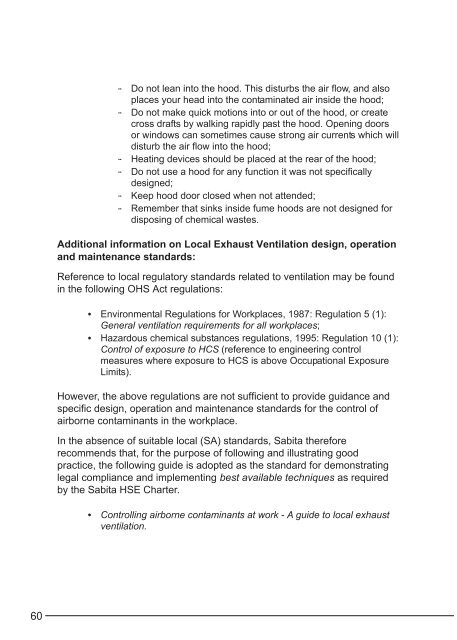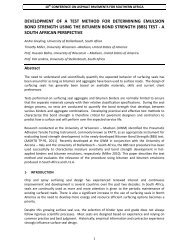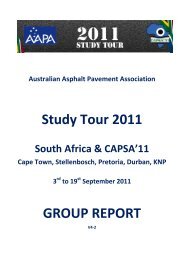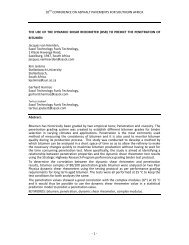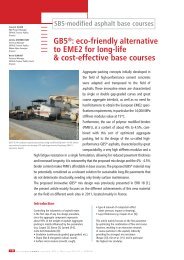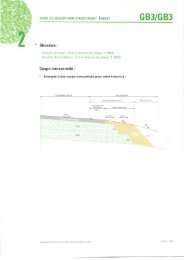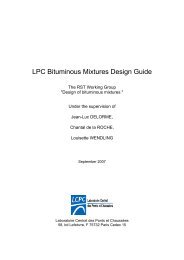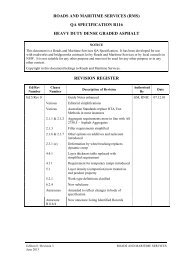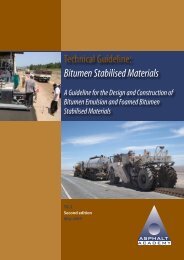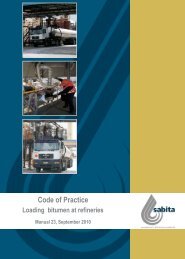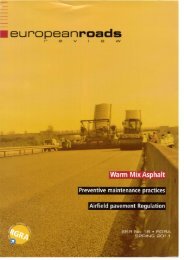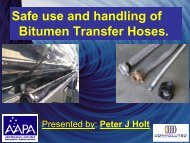Guide to the safe handling of solvents in a bituminous ... - Aapaq.org
Guide to the safe handling of solvents in a bituminous ... - Aapaq.org
Guide to the safe handling of solvents in a bituminous ... - Aapaq.org
- No tags were found...
Create successful ePaper yourself
Turn your PDF publications into a flip-book with our unique Google optimized e-Paper software.
¨¨¨¨¨¨Do not lean <strong>in</strong><strong>to</strong> <strong>the</strong> hood. This disturbs <strong>the</strong> air flow, and alsoplaces your head <strong>in</strong><strong>to</strong> <strong>the</strong> contam<strong>in</strong>ated air <strong>in</strong>side <strong>the</strong> hood;Do not make quick motions <strong>in</strong><strong>to</strong> or out <strong>of</strong> <strong>the</strong> hood, or createcross drafts by walk<strong>in</strong>g rapidly past <strong>the</strong> hood. Open<strong>in</strong>g doorsor w<strong>in</strong>dows can sometimes cause strong air currents which willdisturb <strong>the</strong> air flow <strong>in</strong><strong>to</strong> <strong>the</strong> hood;Heat<strong>in</strong>g devices should be placed at <strong>the</strong> rear <strong>of</strong> <strong>the</strong> hood;Do not use a hood for any function it was not specificallydesigned;Keep hood door closed when not attended;Remember that s<strong>in</strong>ks <strong>in</strong>side fume hoods are not designed fordispos<strong>in</strong>g <strong>of</strong> chemical wastes.Additional <strong>in</strong>formation on Local Exhaust Ventilation design, operationand ma<strong>in</strong>tenance standards:Reference <strong>to</strong> local regula<strong>to</strong>ry standards related <strong>to</strong> ventilation may be found<strong>in</strong> <strong>the</strong> follow<strong>in</strong>g OHS Act regulations:• Environmental Regulations for Workplaces, 1987: Regulation 5 (1):General ventilation requirements for all workplaces;• Hazardous chemical substances regulations, 1995: Regulation 10 (1):Control <strong>of</strong> exposure <strong>to</strong> HCS (reference <strong>to</strong> eng<strong>in</strong>eer<strong>in</strong>g controlmeasures where exposure <strong>to</strong> HCS is above Occupational ExposureLimits).However, <strong>the</strong> above regulations are not sufficient <strong>to</strong> provide guidance andspecific design, operation and ma<strong>in</strong>tenance standards for <strong>the</strong> control <strong>of</strong>airborne contam<strong>in</strong>ants <strong>in</strong> <strong>the</strong> workplace.In <strong>the</strong> absence <strong>of</strong> suitable local (SA) standards, Sabita <strong>the</strong>reforerecommends that, for <strong>the</strong> purpose <strong>of</strong> follow<strong>in</strong>g and illustrat<strong>in</strong>g goodpractice, <strong>the</strong> follow<strong>in</strong>g guide is adopted as <strong>the</strong> standard for demonstrat<strong>in</strong>glegal compliance and implement<strong>in</strong>g best available techniques as requiredby <strong>the</strong> Sabita HSE Charter.• Controll<strong>in</strong>g airborne contam<strong>in</strong>ants at work - A guide <strong>to</strong> local exhaustventilation.60


